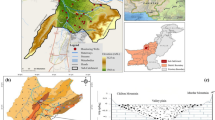Abstract
Ajman is a rapidly urbanizing emirate with land development succeeding at a fast pace. This study aims to monitor land use/land cover changes and assesses the impact of these changes on groundwater quality and quantity of the shallow aquifer using multitemporal remote sensing data and geographic information system (GIS). To monitor the land use/land cover changes, the Spectral Angle Mapper (SAM) and the Normalized Difference Vegetation Index (NDVI) algorithms were utilized. The obtained maps were correlated against a set of total dissolved solid (TDS); Mg, Cl, and NO3 groundwater quality index; and depth to the groundwater table maps constructed from groundwater data. The spatial analysis revealed a sharp depletion in groundwater quality and quantity related to the increase in the land use/land cover classes. The mean total TDS is from 21,971 to 26,450 mg/L and depth to groundwater level from −12.33 to −17.2 m over a period of 15 years. Maps of normalized difference and groundwater quality sustainability showed that the eastern side of the study area has a high value of groundwater quality sustainability and normalized difference, while the western side of the study area has a minimal value of groundwater quality sustainability and normalized difference. This study is of great assistance for decision makers and land developers to relate to municipal land allotment in rapidly developing regions such as Ajman.












Similar content being viewed by others
References
Al-Zabet T (2002) Evaluation of aquifer vulnerability to contamination potential using the DRASTIC method. Environ Geol 43:203–208. doi:10.1007/s00254-002-0645-5
Appleyard S (1995) The impact of urban development on recharge and groundwater quality in a coastal aquifer near Perth, Western Australia. Hydrogeology Journal 3(2):65–75. doi:10.1007/s12517-016-2725-y
Babiker IS, Mohamed MA, Hiyama T (2007) Assessing ground-water quality using GIS. Water Resour Manag 21:699–715
Chavez PS (1996) Image-based atmospheric correction—revised and improved. Photogramm Eng Remote Sens 62:1025–1036
Crouvi O, Ben-Dor E, Beyth M, Avigad D, Amit R (2006) Quantitative mapping of arid alluvial fan surfaces using field spectrometer and hyperspectral remote sensing. Remote Sens Environ 104:103–117
Eliason EM, McEwen AS (1990) Adaptive box filters for removal of random noise from digital images, Photogrammetric Engineering & Remote Sensing, April. V56 No. 4, p. 453.
Kruse FA, Lefkoff JB, Boardman KB, Heidebrecht AT, Shapiro PJ, Barloon Goetz AF (1993) The spectral image processing system (SIPS)—interactive visualization and analysis of imaging spectrometer data. Remote Sensing of the Environment v. 44, p. 145–163.
Hirschberg KJ (1991) Inventory of known and inferred point sources of groundwater contamination in the Perth basin: Western Australia Department of Mines, Western Australia Geological Survey Record 1991–1997.
Khalifa MA (1997) Hydrogeology of the geothermal fractured rock well field at Jabal Hafit, Abu Dhabi Emirate. Proceedings of the 3rd Gulf Water Conference, Muscat, 1997, pp. 125–140.
Khan HH, Khan A, Ahmed S, Perrin J (2011) GIS-based impact assessment of land-use changes on groundwater quality: study from a rapidly urbanizing region of South India. Environmental Earth Sciences 63(6):1289–1302
Krapac IG, Dey WS, Roy WR, Jellerichs, BG, Symth C, Moore JA (2000) Groundwater quality near livestock manure pits. In Animal, agricultural and food processing wastes. Proceedings of the Eighth International Symposium, Des Moines, Iowa, USA, 9-11 October, 2000. (pp. 710–718). American Society of Agricultural Engineers.
Mohamed MM, Al-Mualla AA (2010) Water demand forecasting in Umm Al-Quwain using the constant rate model. Desalination, 259(1):161–168.
Mohamed MM, Elmahdy SI (2016) Remote sensing and information value (IV) model for regional mapping of fluvial channels and topographic wetness in the Saudi Arabia. GIScience & Remote Sensing:1–22
Nas B, Berktay A (2008) Groundwater quality mapping in urban groundwater using GIS. Environ Monit Assess 160(1–4):215–227
Panno SV, Hackley KC, Hwang HH, Kelly WR (2001) Determination of the sources of nitrate contamination in karst springs using isotopic and chemical indicators. Chemical Geology 179(1):113–128
Pionke HB, Sharma ML, Hirschberg KJ (1990) Impact of irrigated horticulture on nitrate concentrations in groundwater. Agriculture, Ecosystems & Environment 32(1–2):119–132.
Schmidt KD (1977) Water quality variations for pumping wells. Ground Water 15(2):130–137
Schmitt A, Brisco B (2013) Wetland monitoring using the curvelet-based change detection method on polarimetric SAR imagery. Water 5:1036–1051
UNESCO/WHO/UNEP (1996). Water Quality Assessments—a guide to use of biota, sediments and water in environmental monitoring. 2nd edn. In: Chapman D (ed) Chapman & Hall Publishers. ISBN 0419215905(HB) 0419 216006 (PB)
Voznaya EE, Tikhomolova KP, Taevere ED (1981) Effect of the nature of the hydrocarbon and the electrolyte cation on the electroosmosis of 2 immiscible liquids. Colloid Journal of the USSR, 43(4), 602-607
WHO (2004) Guidelines for drinking-water quality, vol 1, 3rd edn, recommendations. WHO, Geneva, Switzerland, pp. 145–220
Acknowledgments
The authors acknowledge the assistance provided by the UAE National Water Center (NWC) and the UAE University Program for Advanced Research (UPAR).
Author information
Authors and Affiliations
Corresponding author
Ethics declarations
Funding
This research was supported by funds from the UAE National Water Center (NWC) and the UAE University Program for Advanced Research (UPAR) (projects numbers NWC-3-2013-31R008 and UPAR-7-2013-31N166).
Rights and permissions
About this article
Cite this article
Elmahdy, S.I., Mohamed, M.M. Land use/land cover change impact on groundwater quantity and quality: a case study of Ajman Emirate, the United Arab Emirates, using remote sensing and GIS. Arab J Geosci 9, 722 (2016). https://doi.org/10.1007/s12517-016-2725-y
Received:
Accepted:
Published:
DOI: https://doi.org/10.1007/s12517-016-2725-y




